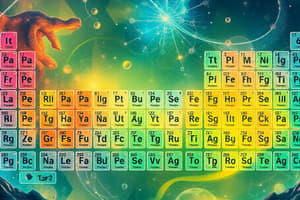Podcast
Questions and Answers
What is the primary purpose of effective communication?
What is the primary purpose of effective communication?
- To establish and maintain relationships (correct)
- To gather information from others
- To convince others of your perspective
- To express feelings and emotions clearly
Which element does NOT contribute to effective communication?
Which element does NOT contribute to effective communication?
- Use of technical jargon (correct)
- Active listening
- Empathy towards the speaker
- Clarification of message
Which barrier can hinder effective communication?
Which barrier can hinder effective communication?
- Clear messaging
- Cultural understanding
- Emotional distractions (correct)
- Well-structured feedback
What role does feedback play in communication?
What role does feedback play in communication?
How can nonverbal cues affect communication?
How can nonverbal cues affect communication?
Flashcards
String
String
A sequence of characters, such as letters, numbers, and symbols.
Boolean
Boolean
A value that can be either true or false.
Dictionary
Dictionary
A data structure that represents a collection of key-value pairs.
List
List
Signup and view all the flashcards
Set
Set
Signup and view all the flashcards
Study Notes
P-Block Elements
- Elements in the p-block of the periodic table have their outermost electrons in the p subshells.
- They exhibit a wide range of properties, including metallic, metalloid, and non-metallic characteristics.
- The elements in Group 15 (VA) are called the nitrogen family.
- They have five valence electrons (ns²np³).
- Key elements in this group include nitrogen (N), phosphorus (P), arsenic (As), antimony (Sb), and bismuth (Bi).
- Group 15 elements show different properties. Nitrogen is a nonmetal; for phosphorus and arsenic, they are metalloids; antimony and bismuth have metallic properties respectively.
Group 15 (VA) Elements
- They have an outermost electronic configuration of ns²np³.
- General outermost electronic configuration is ns²np³.
- Valence electrons equal 5, valency equal 3 or 5.
- All the elements of group 15, except nitrogen, exhibit allotropy.
- Nitrogen is a diatomic gas, and for other members of the family, they exist as solids.
- The oxides of these elements exhibit a variation in acidic/basic properties
- Nitrogen (N₂) is less reactive as it has strong triple bonds and it's inert.
- Except nitrogen, elements of group 15 form trihalides (e.g., NCl₃, PCl₃, AsCl₃, SbCl₃, and BiCl₃) and pentahalides (e.g., PCl₅, AsCl₅, SbCl₅, and BiCl₅).
- Nitrogen exists as a diatomic molecule (N₂). Other elements in the group exist as solids (P, As, Sb, Bi).
Properties of Group 15 Elements
- Physical State: Nitrogen is a diatomic gas. Phosphorus, arsenic, antimony, and bismuth are solids.
- Electrical Conductivity: Electrical conductivity increases down the group.
Occurrence
- Nitrogen is the most abundant element in the atmosphere (78%).
- Phosphorus occurs in phosphate rocks and minerals.
- Arsenic, antimony, and bismuth occur in sulfide ores.
Oxidation States
- The variable oxidation states of Group 15 elements range from -3 to +5.
Reactivity of Group 15 Elements
- Reactivity towards Hydrogen: Nitrogen reacts with hydrogen at high temperatures and pressures in the presence of catalyst. Whereas phosphorus and other members react with hydrogen at lower temperatures.
- Reactivity towards Oxygen: N reacts with oxygen at high temperature to form nitrogen oxides. Whereas phosphorous, arsenic, antimony, and bismuth react directly with oxygen at normal temperature forming trioxides or pentaoxides.
- Reactivity towards Halogen: All the group 15 members react with halogens to form trihalides and pentahalides. Nitrogen forms trihalides. Phosphorous and other members of the group form tri as well as pentahalides.
Important Compounds of N₂
- Ammonia (NH₃): A colorless gas with a pungent odor.
- Nitric acid (HNO₃): A strong oxidizing acid used in various industrial processes.
- Dinitrogen (N₂): The major component of the Earth's atmosphere.
Electronic Configuration
- Electronic configurations for elements in group 15 are given.
Physical State
- Physical state of different elements are given.
Boiling Point
- The boiling points of elements in group 15 are provided.
Oxidation States and Important Compounds
- Oxidation states and important compounds of the elements are listed.
Electronegativity
- The electronegativity values for group 15 elements are provided.
Metallic Character
- The metallic character of the elements is noted in the group.
Studying That Suits You
Use AI to generate personalized quizzes and flashcards to suit your learning preferences.




